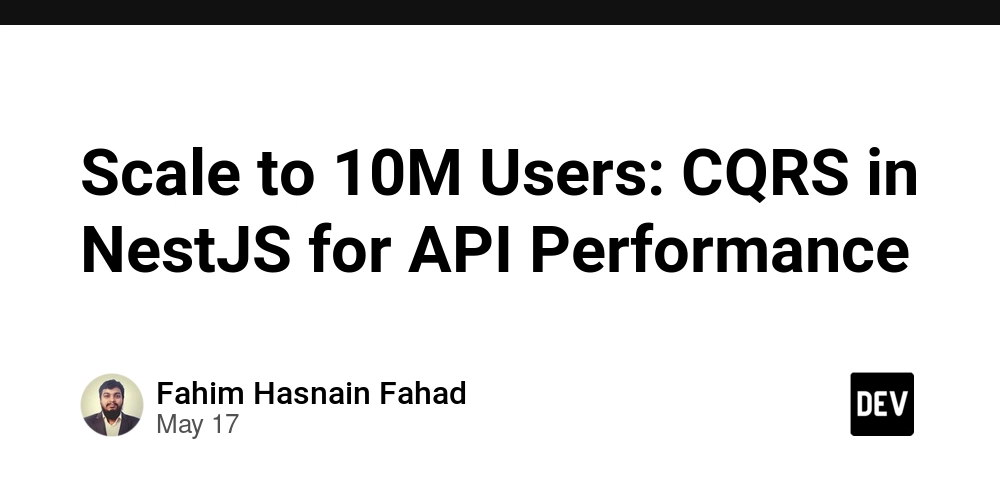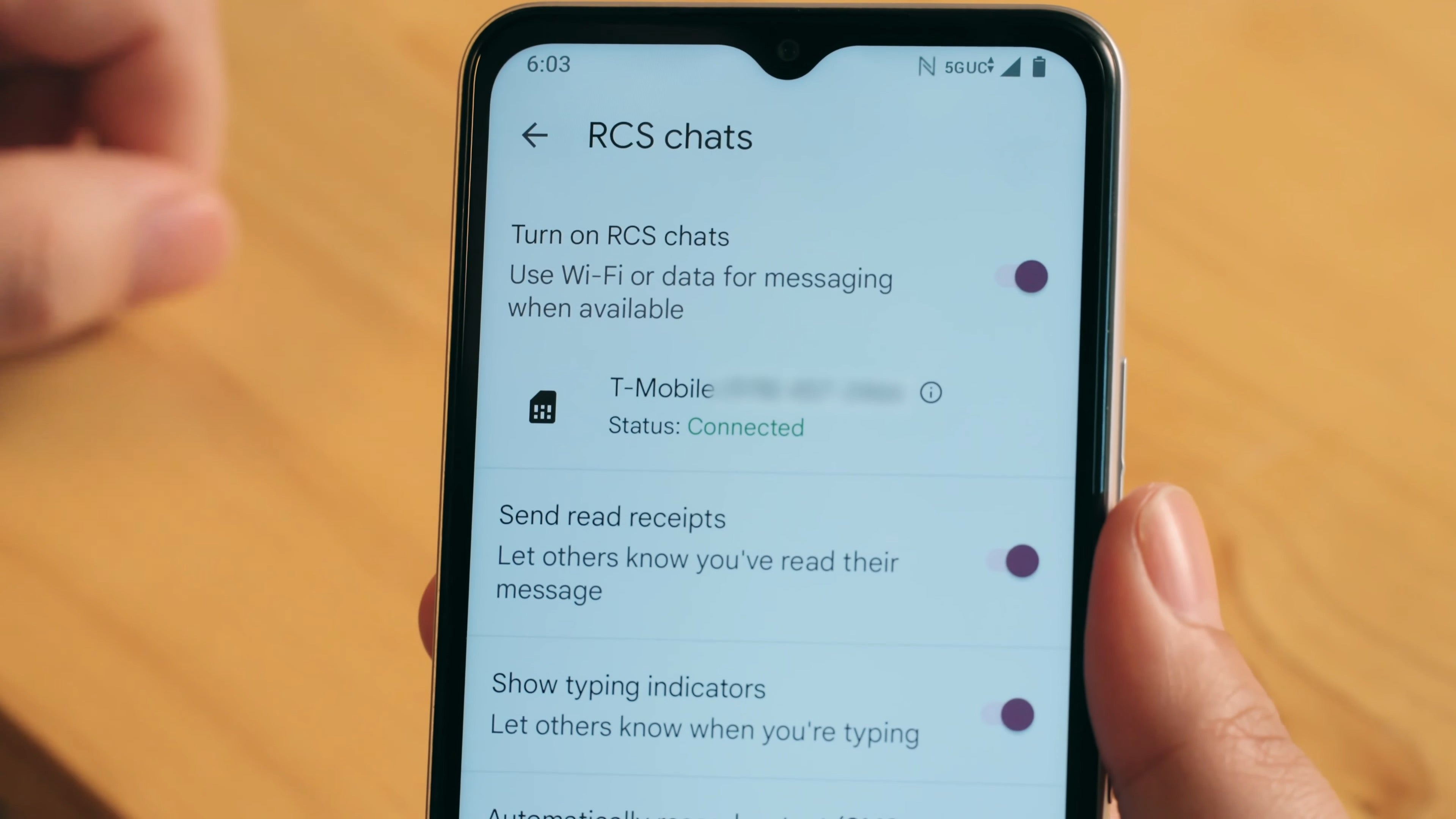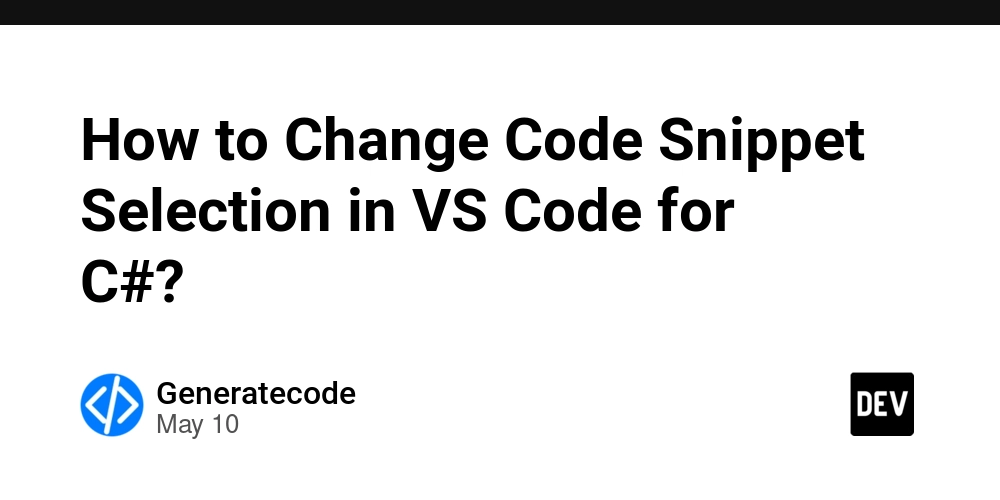Scale to 10M Users: CQRS in NestJS for API Performance
Scale to 10M Users: CQRS in NestJS for API Performance In today's digital landscape, building applications that can handle millions of users requires thoughtful architecture decisions. Command Query Responsibility Segregation (CQRS) is one such pattern that helps maintain performance at scale. Let's explore! What is CQRS and Why Use It? CQRS splits your application into two models: Command model: Handles create, update, and delete operations Query model: Manages read operations This separation addresses the reality that most applications have asymmetric read/write loads—typically with reads far outnumbering writes. Setting Up CQRS in NestJS First, install the required packages: npm install @nestjs/cqrs uuid kafkajs redis mongodb pg Directory Structure src/ ├── commands/ │ ├── handlers/ │ ├── impl/ ├── queries/ │ ├── handlers/ │ ├── impl/ ├── events/ ├── models/ ├── controllers/ └── app.module.ts Basic Implementation Let's start with our app.module.ts: import { Module } from '@nestjs/common'; import { CqrsModule } from '@nestjs/cqrs'; import { MongooseModule } from '@nestjs/mongoose'; import { TypeOrmModule } from '@nestjs/typeorm'; import { CommandHandlers } from './commands/handlers'; import { QueryHandlers } from './queries/handlers'; import { EventHandlers } from './events/handlers'; import { Controllers } from './controllers'; @Module({ imports: [ CqrsModule, MongooseModule.forRoot('mongodb://localhost:27017/cqrs_read'), TypeOrmModule.forRoot({ type: 'postgres', host: 'localhost', port: 5432, username: 'postgres', password: 'password', database: 'cqrs_write', entities: [__dirname + '/**/*.entity{.ts,.js}'], synchronize: true, }), ], controllers: [...Controllers], providers: [ ...CommandHandlers, ...QueryHandlers, ...EventHandlers, ], }) export class AppModule {} Now, let's define a command: // commands/impl/create-user.command.ts export class CreateUserCommand { constructor( public readonly email: string, public readonly name: string, ) {} } And its handler: // commands/handlers/create-user.handler.ts import { CommandHandler, ICommandHandler, EventBus } from '@nestjs/cqrs'; import { InjectRepository } from '@nestjs/typeorm'; import { Repository } from 'typeorm'; import { CreateUserCommand } from '../impl/create-user.command'; import { User } from '../../models/user.entity'; import { UserCreatedEvent } from '../../events/impl/user-created.event'; @CommandHandler(CreateUserCommand) export class CreateUserHandler implements ICommandHandler { constructor( @InjectRepository(User) private userRepository: Repository, private eventBus: EventBus, ) {} async execute(command: CreateUserCommand): Promise { const { email, name } = command; const user = new User(); user.email = email; user.name = name; const savedUser = await this.userRepository.save(user); // Publish event for read model synchronization this.eventBus.publish(new UserCreatedEvent(savedUser.id, email, name)); return savedUser; } } Query Side with MongoDB For read operations, we'll use MongoDB for its superior query performance: // queries/impl/get-user.query.ts export class GetUserQuery { constructor(public readonly id: string) {} } // queries/handlers/get-user.handler.ts import { QueryHandler, IQueryHandler } from '@nestjs/cqrs'; import { InjectModel } from '@nestjs/mongoose'; import { Model } from 'mongoose'; import { GetUserQuery } from '../impl/get-user.query'; import { UserReadModel } from '../../models/user.read-model'; @QueryHandler(GetUserQuery) export class GetUserHandler implements IQueryHandler { constructor( @InjectModel(UserReadModel.name) private userModel: Model, ) {} async execute(query: GetUserQuery): Promise { return this.userModel.findOne({ userId: query.id }).exec(); } } Synchronizing Read/Write Models with Kafka To keep our read model updated, we'll use Kafka for event sourcing: // events/handlers/user-created.handler.ts import { EventsHandler, IEventHandler } from '@nestjs/cqrs'; import { Inject } from '@nestjs/common'; import { ClientKafka } from '@nestjs/microservices'; import { UserCreatedEvent } from '../impl/user-created.event'; @EventsHandler(UserCreatedEvent) export class UserCreatedHandler implements IEventHandler { constructor( @Inject('KAFKA_SERVICE') private kafkaClient: ClientKafka ) {} handle(event: UserCreatedEvent) { this.kafkaClient.emit('user-created', { id: event.id, email: event.email, name: event.name, timestamp: new Date().toISOString() }); } } And our consumer service: // services/read-model-sync.service.ts import { Injectable, OnModuleInit } from '@nestjs/common'; import { InjectModel } from '@nestjs/mongoose'; import { Model }

Scale to 10M Users: CQRS in NestJS for API Performance
In today's digital landscape, building applications that can handle millions of users requires thoughtful architecture decisions. Command Query Responsibility Segregation (CQRS) is one such pattern that helps maintain performance at scale. Let's explore!
What is CQRS and Why Use It?
CQRS splits your application into two models:
- Command model: Handles create, update, and delete operations
- Query model: Manages read operations
This separation addresses the reality that most applications have asymmetric read/write loads—typically with reads far outnumbering writes.
Setting Up CQRS in NestJS
First, install the required packages:
npm install @nestjs/cqrs uuid kafkajs redis mongodb pg
Directory Structure
src/
├── commands/
│ ├── handlers/
│ ├── impl/
├── queries/
│ ├── handlers/
│ ├── impl/
├── events/
├── models/
├── controllers/
└── app.module.ts
Basic Implementation
Let's start with our app.module.ts:
import { Module } from '@nestjs/common';
import { CqrsModule } from '@nestjs/cqrs';
import { MongooseModule } from '@nestjs/mongoose';
import { TypeOrmModule } from '@nestjs/typeorm';
import { CommandHandlers } from './commands/handlers';
import { QueryHandlers } from './queries/handlers';
import { EventHandlers } from './events/handlers';
import { Controllers } from './controllers';
@Module({
imports: [
CqrsModule,
MongooseModule.forRoot('mongodb://localhost:27017/cqrs_read'),
TypeOrmModule.forRoot({
type: 'postgres',
host: 'localhost',
port: 5432,
username: 'postgres',
password: 'password',
database: 'cqrs_write',
entities: [__dirname + '/**/*.entity{.ts,.js}'],
synchronize: true,
}),
],
controllers: [...Controllers],
providers: [
...CommandHandlers,
...QueryHandlers,
...EventHandlers,
],
})
export class AppModule {}
Now, let's define a command:
// commands/impl/create-user.command.ts
export class CreateUserCommand {
constructor(
public readonly email: string,
public readonly name: string,
) {}
}
And its handler:
// commands/handlers/create-user.handler.ts
import { CommandHandler, ICommandHandler, EventBus } from '@nestjs/cqrs';
import { InjectRepository } from '@nestjs/typeorm';
import { Repository } from 'typeorm';
import { CreateUserCommand } from '../impl/create-user.command';
import { User } from '../../models/user.entity';
import { UserCreatedEvent } from '../../events/impl/user-created.event';
@CommandHandler(CreateUserCommand)
export class CreateUserHandler implements ICommandHandler<CreateUserCommand> {
constructor(
@InjectRepository(User)
private userRepository: Repository<User>,
private eventBus: EventBus,
) {}
async execute(command: CreateUserCommand): Promise<User> {
const { email, name } = command;
const user = new User();
user.email = email;
user.name = name;
const savedUser = await this.userRepository.save(user);
// Publish event for read model synchronization
this.eventBus.publish(new UserCreatedEvent(savedUser.id, email, name));
return savedUser;
}
}
Query Side with MongoDB
For read operations, we'll use MongoDB for its superior query performance:
// queries/impl/get-user.query.ts
export class GetUserQuery {
constructor(public readonly id: string) {}
}
// queries/handlers/get-user.handler.ts
import { QueryHandler, IQueryHandler } from '@nestjs/cqrs';
import { InjectModel } from '@nestjs/mongoose';
import { Model } from 'mongoose';
import { GetUserQuery } from '../impl/get-user.query';
import { UserReadModel } from '../../models/user.read-model';
@QueryHandler(GetUserQuery)
export class GetUserHandler implements IQueryHandler<GetUserQuery> {
constructor(
@InjectModel(UserReadModel.name)
private userModel: Model<UserReadModel>,
) {}
async execute(query: GetUserQuery): Promise<UserReadModel> {
return this.userModel.findOne({ userId: query.id }).exec();
}
}
Synchronizing Read/Write Models with Kafka
To keep our read model updated, we'll use Kafka for event sourcing:
// events/handlers/user-created.handler.ts
import { EventsHandler, IEventHandler } from '@nestjs/cqrs';
import { Inject } from '@nestjs/common';
import { ClientKafka } from '@nestjs/microservices';
import { UserCreatedEvent } from '../impl/user-created.event';
@EventsHandler(UserCreatedEvent)
export class UserCreatedHandler implements IEventHandler<UserCreatedEvent> {
constructor(
@Inject('KAFKA_SERVICE') private kafkaClient: ClientKafka
) {}
handle(event: UserCreatedEvent) {
this.kafkaClient.emit('user-created', {
id: event.id,
email: event.email,
name: event.name,
timestamp: new Date().toISOString()
});
}
}
And our consumer service:
// services/read-model-sync.service.ts
import { Injectable, OnModuleInit } from '@nestjs/common';
import { InjectModel } from '@nestjs/mongoose';
import { Model } from 'mongoose';
import { Consumer, Kafka } from 'kafkajs';
import { UserReadModel } from '../models/user.read-model';
@Injectable()
export class ReadModelSyncService implements OnModuleInit {
private consumer: Consumer;
constructor(
@InjectModel(UserReadModel.name)
private userModel: Model<UserReadModel>,
) {
const kafka = new Kafka({
clientId: 'read-model-sync',
brokers: ['localhost:9092'],
});
this.consumer = kafka.consumer({ groupId: 'read-model-sync-group' });
}
async onModuleInit() {
await this.consumer.connect();
await this.consumer.subscribe({ topic: 'user-created', fromBeginning: true });
await this.consumer.run({
eachMessage: async ({ topic, message }) => {
const eventData = JSON.parse(message.value.toString());
if (topic === 'user-created') {
await this.userModel.updateOne(
{ userId: eventData.id },
{
userId: eventData.id,
email: eventData.email,
name: eventData.name,
updatedAt: new Date()
},
{ upsert: true }
);
}
},
});
}
}
To further enhance read performance, we can add Redis Caching for Read Queries.











































































































































































![[The AI Show Episode 146]: Rise of “AI-First” Companies, AI Job Disruption, GPT-4o Update Gets Rolled Back, How Big Consulting Firms Use AI, and Meta AI App](https://www.marketingaiinstitute.com/hubfs/ep%20146%20cover.png)



























































































































![[FREE EBOOKS] Modern Generative AI with ChatGPT and OpenAI Models, Offensive Security Using Python & Four More Best Selling Titles](https://www.javacodegeeks.com/wp-content/uploads/2012/12/jcg-logo.jpg)




![How to make Developer Friends When You Don't Live in Silicon Valley, with Iraqi Engineer Code;Life [Podcast #172]](https://cdn.hashnode.com/res/hashnode/image/upload/v1747360508340/f07040cd-3eeb-443c-b4fb-370f6a4a14da.png?#)











































































































































![[Virtual Event] Strategic Security for the Modern Enterprise](https://eu-images.contentstack.com/v3/assets/blt6d90778a997de1cd/blt55e4e7e277520090/653a745a0e92cc040a3e9d7e/Dark_Reading_Logo_VirtualEvent_4C.png?width=1280&auto=webp&quality=80&disable=upscale#)
















































































-xl-(1)-xl-xl.jpg)












![Upgrade your CarPlay experience in 2025 with Ottocast NanoAI and Mini Wireless [20% off]](https://i0.wp.com/9to5mac.com/wp-content/uploads/sites/6/2025/05/nano-ai-banner-pc.jpg?resize=1200%2C628&quality=82&strip=all&ssl=1)














![iPhone 17 Air Could Get a Boost From TDK's New Silicon Battery Tech [Report]](https://www.iclarified.com/images/news/97344/97344/97344-640.jpg)
![Vision Pro Owners Say They Regret $3,500 Purchase [WSJ]](https://www.iclarified.com/images/news/97347/97347/97347-640.jpg)
![Apple Showcases 'Magnifier on Mac' and 'Music Haptics' Accessibility Features [Video]](https://www.iclarified.com/images/news/97343/97343/97343-640.jpg)
![Sony WH-1000XM6 Unveiled With Smarter Noise Canceling and Studio-Tuned Sound [Video]](https://www.iclarified.com/images/news/97341/97341/97341-640.jpg)



































































